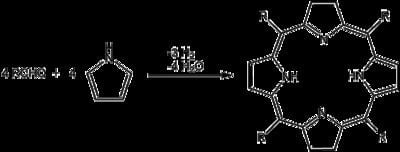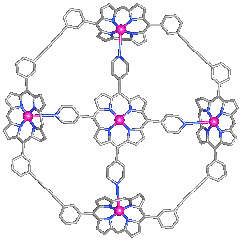 | ||
Synthesis of heme porphyrin ring
Porphyrins are a group of heterocyclic macrocycle organic compounds, composed of four modified pyrrole subunits interconnected at their α carbon atoms via methine bridges (=CH−). The parent porphyrin is porphin, and substituted porphines are called porphyrins. The porphyrin ring structure is aromatic, with a total of 26 electrons in the conjugated system. Various analyses indicate that not all atoms of the ring are involved equally in the conjugation or that the molecule's overall nature is substantially based on several smaller conjugated systems. One result of the large conjugated system is that porphyrin molecules typically have very intense absorption bands in the visible region and may be deeply colored; the name "porphyrin" comes from the Greek word πορφύρα (porphyra), meaning purple.
Contents
- Synthesis of heme porphyrin ring
- Porphyrin
- Complexes of porphyrins
- Related molecules
- Natural formation
- Biosynthesis
- Laboratory synthesis
- Applications
- Medicine
- Biomimetic catalysis
- Molecular electronics
- Supramolecular chemistry
- Organic geochemistry
- Toxicology
- References

Many porphyrins are naturally occurring; one of the best-known porphyrins is heme, the pigment in red blood cells, a cofactor of the protein hemoglobin.

Porphyrin
Complexes of porphyrins
Porphyrins are the conjugate acids of ligands that bind metals to form complexes. The metal ion usually has a charge of 2+ or 3+. A schematic equation for these syntheses is shown:


A porphyrin without a metal-ion in its cavity is a free base. Some iron-containing porphyrins are called hemes. Heme-containing proteins, or hemoproteins, are found extensively in nature. Hemoglobin and myoglobin are two O2-binding proteins that contain iron porphyrins. Various cytochromes are also hemoproteins.
Related molecules
Several other heterocycles are related to porphyrins. These include corrins, chlorins, bacteriochlorophylls, and corphins. Chlorins (2,3-dihydroporphyrin) are more reduced, contain more hydrogen than porphyrins, and feature a pyrroline subunit. This structure occurs in a chlorophyll molecule. Replacement of two of the four pyrrolic subunits with pyrrolinic subunits results in either a bacteriochlorin (as found in some photosynthetic bacteria) or an isobacteriochlorin, depending on the relative positions of the reduced rings. Some porphyrin derivatives follow Hückel's rule, but most do not.
A benzoporphyrin is a porphyrin with a benzene ring fused to one of the pyrrole units. e.g. verteporfin is a benzoporphyrin derivative.
Natural formation
A geoporphyrin, also known as a petroporphyrin, is a porphyrin of geologic origin. They can occur in crude oil, oil shale, coal, or sedimentary rocks. Abelsonite is possibly the only geoporphyrin mineral, as it is rare for porphyrins to occur in isolation and form crystals.
Biosynthesis
In non-photosynthetic eukaryotes such as animals, insects, fungi, and protozoa, as well as the α-proteobacteria group of bacteria, the committed step for porphyrin biosynthesis is the formation of δ-aminolevulinic acid (δ-ALA, 5-ALA or dALA) by the reaction of the amino acid glycine with succinyl-CoA from the citric acid cycle. In plants, algae, bacteria (except for the α-proteobacteria group) and archaea, it is produced from glutamic acid via glutamyl-tRNA and glutamate-1-semialdehyde. The enzymes involved in this pathway are glutamyl-tRNA synthetase, glutamyl-tRNA reductase, and glutamate-1-semialdehyde 2,1-aminomutase. This pathway is known as the C5 or Beale pathway.
Two molecules of dALA are then combined by porphobilinogen synthase to give porphobilinogen (PBG), which contains a pyrrole ring. Four PBGs are then combined through deamination into hydroxymethyl bilane (HMB), which is hydrolysed to form the circular tetrapyrrole uroporphyrinogen III. This molecule undergoes a number of further modifications. Intermediates are used in different species to form particular substances, but, in humans, the main end-product protoporphyrin IX is combined with iron to form heme. Bile pigments are the breakdown products of heme.
The following scheme summarizes the biosynthesis of porphyrins, with references by EC number and the OMIM database. The porphyria associated with the deficiency of each enzyme is also shown:
Laboratory synthesis
One of the most common syntheses for porphyrins is based on work by Paul Rothemund. His techniques underpin more modern synthesis such as those described by Adler and Longo. The synthesis of simple porphyrins such as meso-tetraphenylporphyrin (H2TPP) is also commonly done in university teaching labs.
The Rothemund synthesis is a condensation and oxidation starting with pyrrole and an aldehyde. In solution-phase synthesis, acidic conditions are essential; formic acid, acetic acid, and propionic acid are typical reaction solvents, or p-toluenesulfonic acid or various Lewis acids can be used with a non-acidic solvent. A large amount of side-product is formed and is removed, usually by recrystallization or chromatography.
Green chemistry variants have been developed in which the reaction is performed with microwave irradiation using reactants adsorbed on acidic silica gel or at high temperature in the gas phase. In these cases, no additional acid is required.
Applications
The main role of porphyrins is their support of aerobic life.
Medicine
Porphyrins have been evaluated in the context of photodynamic therapy since they strongly absorb light, which is then converted to energy and heat in the illuminated areas. This has been applied in macular degeneration using verteporfin. Bacteria have been shown to produce porphyrins endogenously as byproducts in heme biosynthesis, and these can be used in phototherapy to treat bacterial infections, such as acne.
Biomimetic catalysis
Although not commercialized, metalloporphyrin complexes are widely studied as catalysts for the oxidation of organic compounds. Particularly popular for such laboratory research are complexes of meso-tetraphenylporphyrin and octaethylporphyrin. Complexes with Mn, Fe, and Co catalyze a variety of reactions of potential interest in organic synthesis. Some complexes emulate the action of various heme enzymes such as cytochrome P450, lignin peroxidase,
Molecular electronics
Porphyrin-based compounds are of interest in molecular electronics and supramolecular building blocks. Synthetic porphyrin dyes that are incorporated in prototype dye-sensitized solar cells.
Phthalocyanines, which are structurally related to porphyrins, are used in commerce as dyes and catalysts, but porphyrins are not.
Supramolecular chemistry
Porphyrins are often used to construct structures in supramolecular chemistry. These systems take advantage of the Lewis acidity of the metal, typically zinc. An example of a host-guest complex that was constructed from a macrocycle composed of four porphyrins. A guest-free base porphyrin is bound to the center by coordination with its four-pyridine substituents.
Organic geochemistry
The field of organic geochemistry, the study of the impacts and processes that organisms have had on the Earth, had its origins in the isolation of porphyrins from petroleum. This finding helped establish the biological origins of petroleum. Petroleum is sometimes "fingerprinted" by analysis of trace amounts of nickel and vanadyl porphyrins.
Chlorophyll is a magnesium porphyrin, and heme is an iron porphyrin, but neither porphyrin is present in petroleum. On the other hand, nickel and vanadyl porphyrins could be related to catalytic molecules from bacteria that feed primordial hydrocarbons.
Toxicology
Heme biosynthesis is used as biomarker in environmental toxicology studies. While excess production of prophyrins indicate organochlorine exposure, lead inhibits ALA dehydratase enzyme.
